
The original Plymouth Barracuda turned the Valiant into a sporty-looking fastback. Because Plymouth didn’t have the money to change the front of the car much, the Barracuda’s engines were limited by the Valiant’s small engine bay; and the overall look of the car was not as sporty as it could have been.
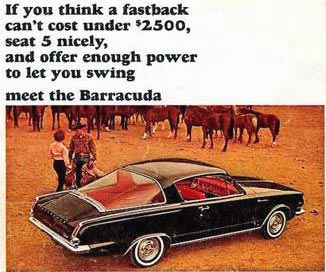
Director of Product Planning Burt Bouwkamp told the executive group that they needed a new body for the Barracuda to be sportier and compete effectively as Mustang, Camaro, Firebird, and Javelin (“compact specialty cars”) sales rose. In 1967, the company projected sales of this class to hit 1.5 million sales in the US alone.

Burt Bouwkamp believed they could have a 15% market share, selling 225,000 per year. He promised the executives at the Corporate Product Planning Committee 200,000 cars a year. “Manufacturing loved the plan because 200,000 cars a year was perfect—two eight-hour shifts at 60 cars per hour.”
Designers started making clay models in 1967; by late 1968, Bill Brownlie and Carl Cameron’s clays looked ready.
At GM, meanwhile, the Oldsmobile Cutlass added a 455 V8 option while the Camaro added a 427 and the Mustang got a 428. Now, the execs felt they needed to match GM and Ford.
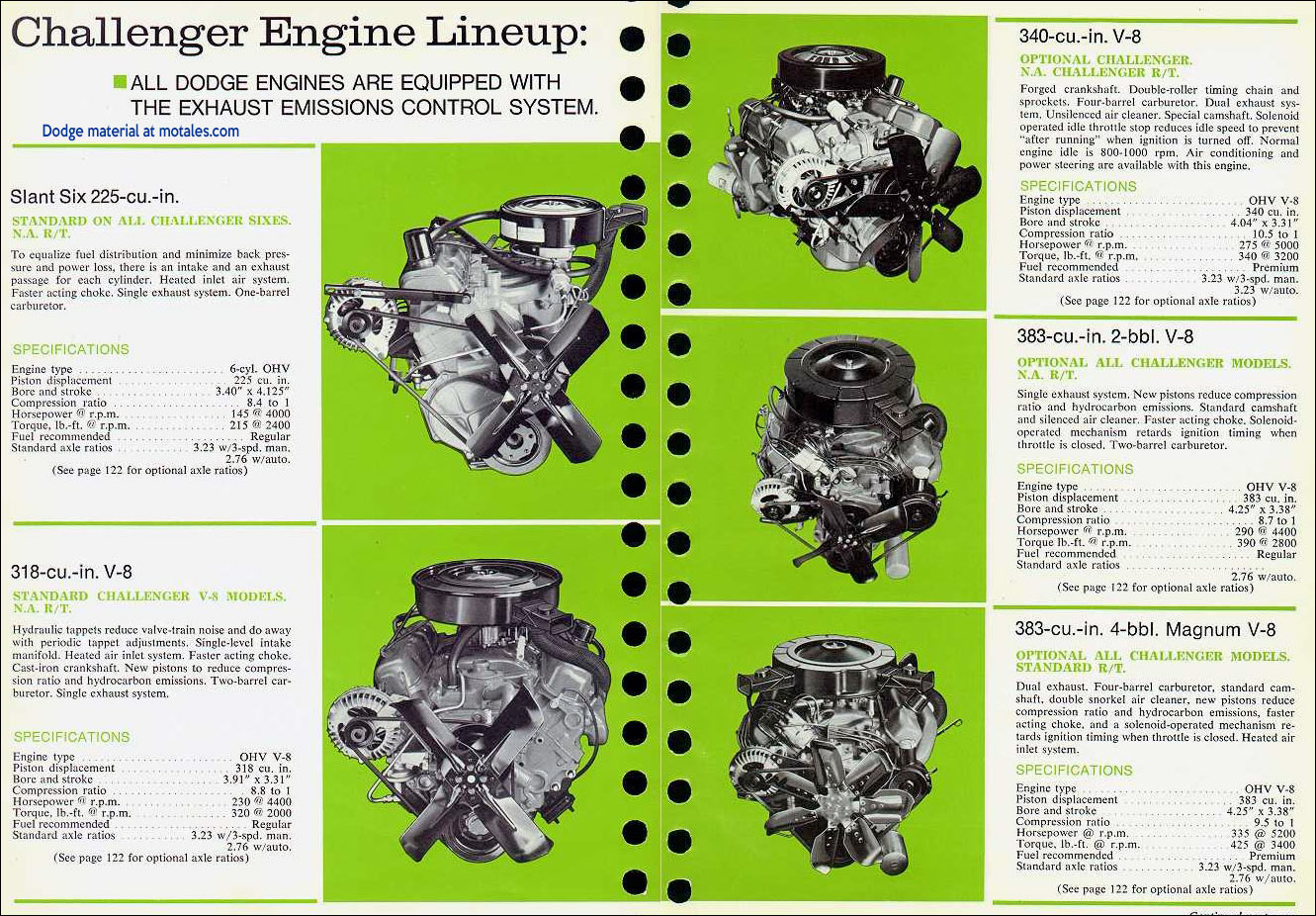
Dodge product planner Roger Struck, who saw the cars from birth through partway into production, later wrote, “It started as a light and nimble ‘secretary’s car’ with Cliff Voss steering the concept. ... the big ‘B’ engines got stuffed in the car and then the car got fat and heavy and eventually led to a forced semi-marriage to the B-Body.”
As Roger wrote, fitting a big block engine required a wider car with wider wheels, adding weight and expense. They switched from using A-body (compact car) engine bay parts and dimensions to B-body (midsize car) engine bay parts and dimensions, including the cowl and everything from the radiator core support to the firewall.
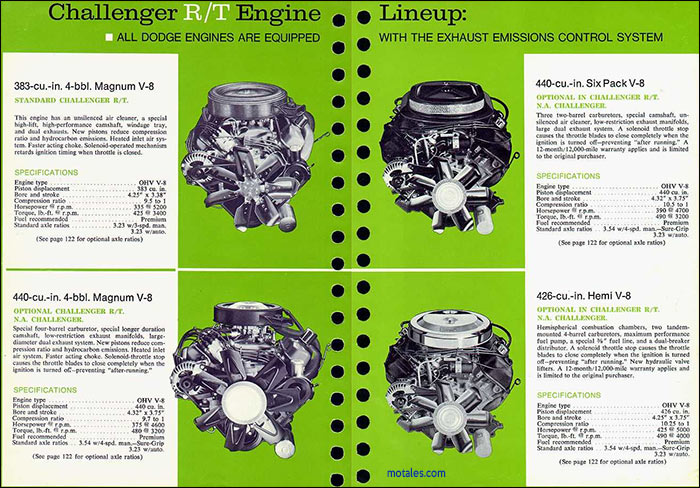
Burt Bouwkamp added,
The B engine option forced a wider car. Also we had to add width for provision for bigger wheels/tires. The additional width helped appearance but of course it added weight and cost.
The Challenger plan was always to share door openings, windshield, cowl and platform with [the new] Barracuda. We also intended to share door outer skins (á la A-body), but during clay model development we decided that this interchangeability formula limited achieving a unique appearance for Challenger, so the door skins became unique. The rest of the interchangeability with Barracuda was in line with the original product plan. Challenger by plan had 2 to 3 inches more wheelbase (á la Dart vs Valiant) than Barracuda, and was also planned to have a $100 higher market price.
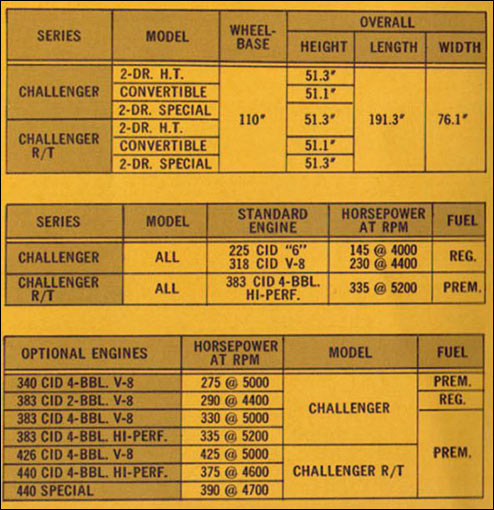
The new body fit between the A and B bodies, but A.5 made no sense, so they called them E bodies—C was the large car and D was Imperial. For added safety, given they were powerful cars to be driven by many younger drivers, the engineers gave Challenger and Barracuda a new energy-absorbing steering column, more roof rollover protection, crash-resistant inner door beams, and safer latch strikers and door handles—features no other Chrysler vehicle had at that point.
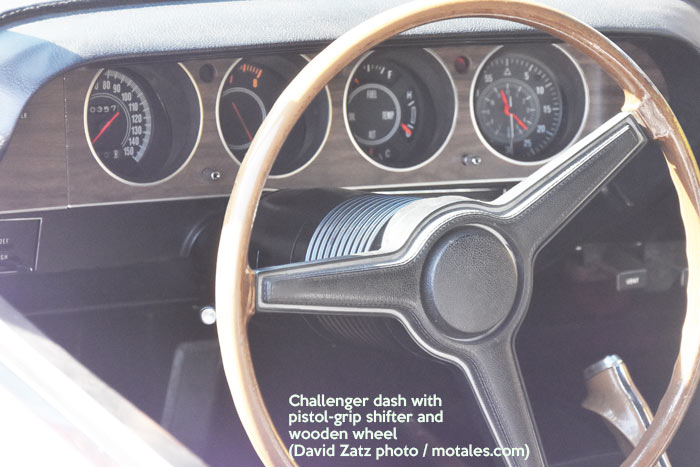
As a sporty car, there were no three-on-the-tree manuals; three and four speed manual transmissions were floor shifts, while the automatic could be either column or console mounted. What’s more, the cheap Valiant/Dart dashboard was ejected in favor of a sporty, four-gauge setup which could, but did not always, include a tachometer—then a pricier item than it is now. One gauge opening provided fuel, oil pressure, temperature, and ammeter gauges; the ammeter, a Chrysler peculiarity, took the place of a voltmeter and told the owner whether the battery was charging or discharging. To make it work, Chrysler ran pretty much all the car’s power into the dashboard and through the gauge; Rick Ehrenberg of Mopar Action and others showed how to use a shunt to avoid the resulting power loss and fire risk.
The Plymouth was theoretically aimed at Camaro and Mustang owners, the Dodge at Mercury Cougar and Pontiac Firebird buyers. Marketers aimed the Dodge at married men with children.
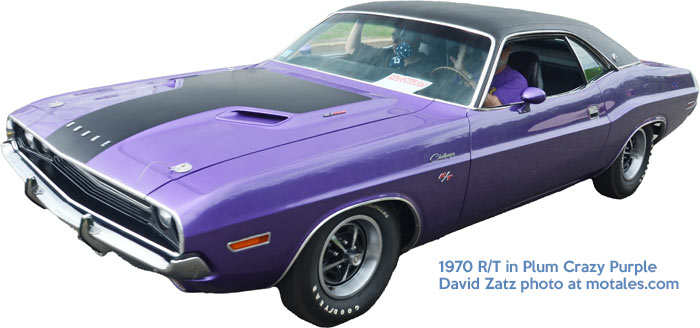
The big day—Job One—was Friday, August 1, 1969. Two lines, Line One and Line Two, of the historic Dodge Main plant in Hamtramck—a multistory building in a largely self-sufficient complex—started making the new Challenger, to be joined in a few weeks by the Los Angeles plant. Line 1 build the big-block specialty cars (including R/T) and convertibles; Line 2 made the rest—cars with 383 or smaller engines—and also made compact Darts and, oddly, the B-body Charger (318 engine only) and Coronet sedan.
The fender tag showed their line as “LN1” or “LN2.” The Los Angeles plant, which only made cars for the West coast, had a single line and also made Darts and such; because it would be too complicated, and comparatively few were sold anyway, California didn’t make any Hemi or Six Pack cars.

The new Plymouth Barracuda, the Challenger’s close sibling, shared a 108-inch wheelbase with the Valiant, 1970 Duster, and 1971 Demon (as shown in the illustration below). To maintain Dodge’s price supremacy over Plymouth, the Challenger had a longer wheelbase of 110 inches—the same as the Dart. The Barracuda and Challenger shared many parts, some glass, and some interior trim, but not as much sheet metal as originally planned. Both had numerous options, trim packages, and colors; “Hi-Impact” colors such as Plum Crazy Purple and Hemi Orange cost Dodge buyers another $14.70, if they chose them. “Bumblebee stripes” were also optional.
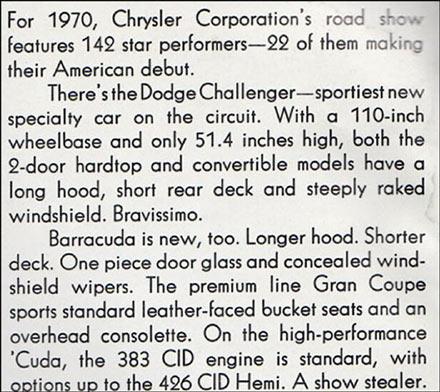
Famed drag racer Don Garlits wrote for an introductory brochure that the Challenger R/T was “Compact like a Dart. Wide like a Charger. Just the right size for anyone who likes his own personalized backyard bomb. ... Challenger and especially Challenger R/T are young people’s cars with young persons’ price tags.” The car certainly was compact like a Dart, as it was originally envisioned as a reskinned one.
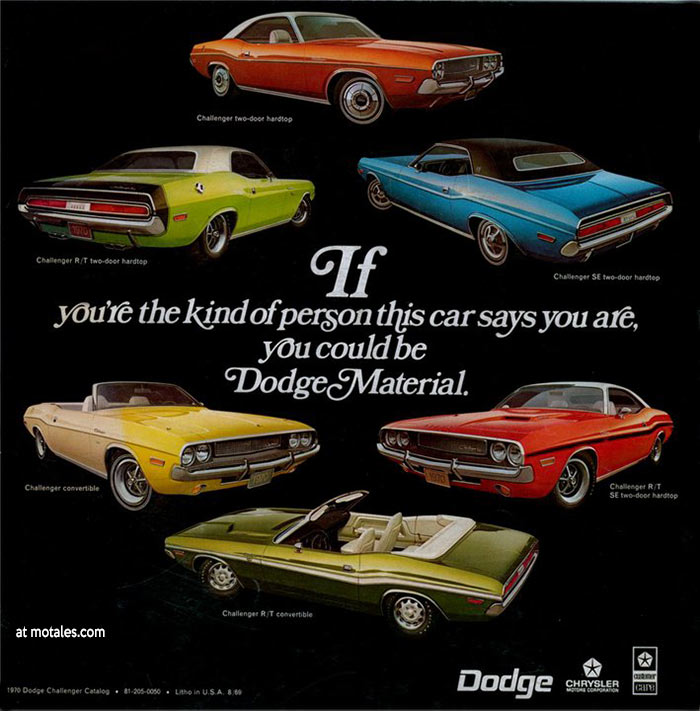
Fresh styling included Chrysler-first flush-mounted pull-up door handles (rather than the old grip-and-push-a-button style) and single-piece front door glass with a hefty curve and no vents (“triangle windows”). The door trim used a high-tech material, polypropylene, molded in 3D with textured surfaces. The latter was something of a disaster, since it had no sound dampening and seemed to amplify any rattles in the door itself. In addition, it was hard to the touch despite the textured surface, and while cheap and good-looking, the material was somewhat unstable. Burton Bouwkamp wrote that each panel was slightly different, a problem for the plants; but it was flexible, so “the assembler could force it to fit.” Critics of the time did not like the new door trim.
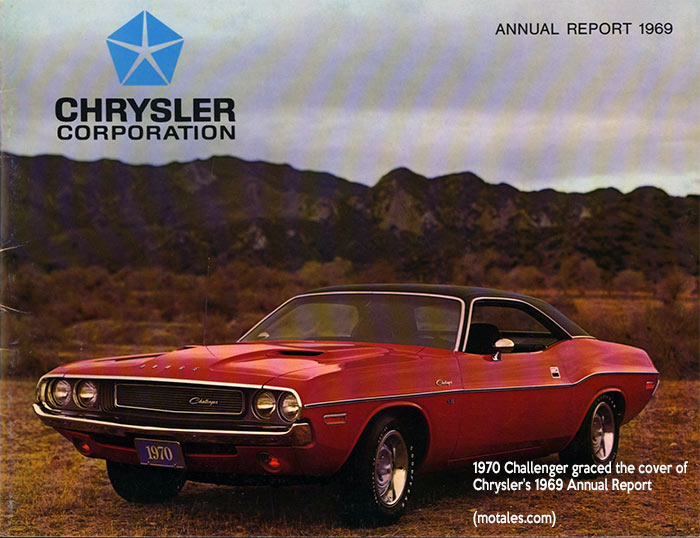
Another modern touch was the Special Edition’s optional overhead console with three warning lights (low fuel, door ajar, seat belts, shown in the ad below). The then-new stereo tape player was also optional, lowing with a headlight delay, rear defroster, power windows, and cruise. Seats could be tilted and moved forward and backward, or vertically (without motors); the front seats were high-back buckets, with bench seats only in the hardtop, and even then having folding center armrests.
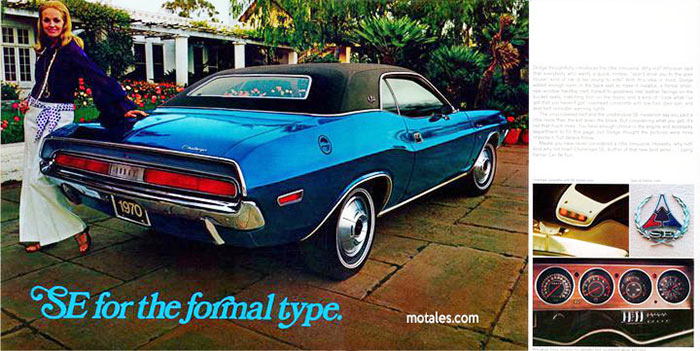
Finally, there were the rear lights. Roger Struck added, “Another feature of the Challenger was the rear wall-to-wall taillights [broken only by the backup lights]. We thought they were the cat’s pajamas. I think they were an industry first.”
Incidentally, the Challenger’s doors weighed 87 pounds before adding hardware and glass, according to assembly worker Bill Wetherholt. Workers used little cranes with hooks when they could, but those were often broken, so they had to pick them up by hand. (Today, doors are set down in rollers, and machines add them to the car.)
The manual transmission was a four-speed for most engines, with automatics having a memorable Slap-Stik Shift Gate option for fast, accurate manual-override shifting. The base three-speed floor-shift transmission had a 2.55:1 first and 1:1 third.
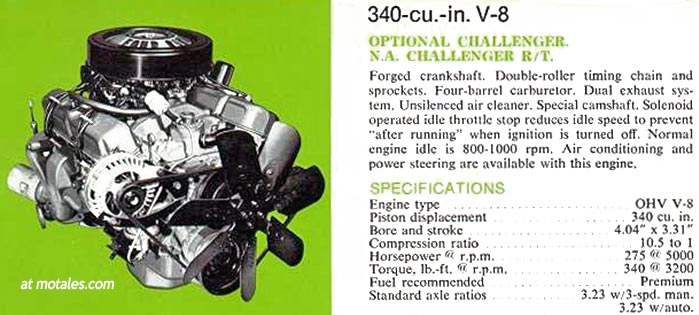
Cars with more powerful engines (340, 383 Magnum, and up) had 15 inch wheels with then-aggressive 60-profile tires; other engines had 14 inch wheels. All tires were fiberglass belted—again, a modern touch—in sizes from E78 to, on the Hemi alone, F60. Wheels were 5.5 inches wide, except for the 340 and Hemi; these powerhouses got seven inch wide wheels. (Why not the 440? That’s unknown.)

They sold few slant sixes, many 318s, many 383s, some 340s, and then few 440s and very very few Hemis. The car was really too heavy for the slant six, producing roughly 100 horsepower in today’s terms (around 140 gross hp); the 318 made it fairly sprightly and the 340 really did it justice, providing a fine combination of balance (the 340 was only a bit heavier than the 318) and power. The 383 was fine for torque but that and the other big-block engines made the car rather front-heavy.
The Challenger R/T started with a 383 V8 producing 335 hp (gross) at 5,200 rpm, which we can estimate to be roughly 280 hp in modern terms; torque was a stump-pulling 425 lb-ft at 3,400 rpm. This 383 Magnum required premium fuel, and used a four-barrel Holley carburetor, hydraulic lifters, and dual, reverse-flow mufflers. The cam had a 268° intake duration and 284° exhaust duration.
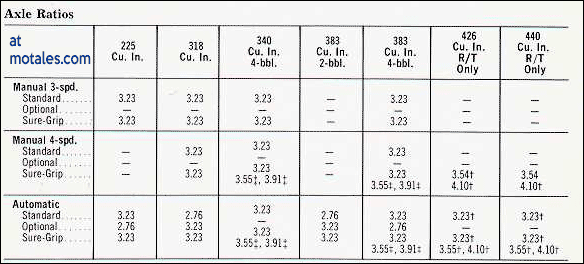
Heavy duty drum brakes were standard, with front discs optional. The R/T also had a “rallye” gauge cluster with a tachometer, oil pressure gauge, and 150-mph speedometer; variable speed wipers; and a choice of stripes (bumblebee or longitudinal tape). Buyers had tall-back vinyl bucket seats and a 3-spoke faux walnut steering wheel, whose appearance didn’t last long. For safety, the R/T included a day/night rear-view mirror.
The variety of engines resulted in a fairly wide range of curb weights: 2,970 to 3,336 pounds. It was not a heavy car by 1970 standards.
The first Hemi Challenger Convertible off the line was converted into a show car, the Dodge Yellowjacket; it previewed the 1971 grille, 1972-74 rear panel, and a not-produced targa style roof. It was somewhat insensitively shown with passers-by invited to draw on a woman’s bare skin to show how customizable the car was—and it was very customizable, since they expected to sell 200,000 per year. Engines ranged from sluggish to monstrous, vinyl tops came in different colors and even Gator Grain (alligator texture, presumably for the University of Florida), and there were many cosmetic and convenience and performance options. They went from a cheap Deputy Coupe with fixed rear glass and a truly basic engine up to the T/A and SE and R/T, even with a 426 Hemi that required chassis work. They even had 3M reflective stripes in fluorescent green and Panther Pink. It was all set up for 200,000 sales per year.
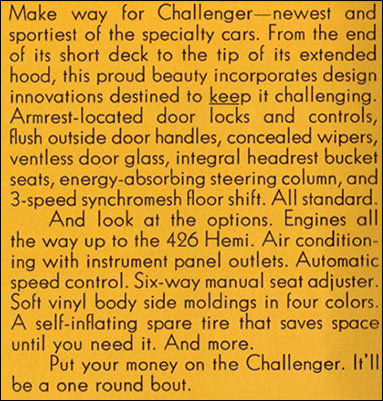
The Yellowjacket show car, incidentally, was repainted for the next show year and dubbed the Dodge Diamante, a name soon taken by Mitsubishi for a luxury car. This version previewed 1972 tail-lights and tested a more aerodynamic nose with popup headlights. The car is still around.
The Highline was the first to launch; it had nearly every possible option, and engines ranged from slant six on up. The base engine was the 340, with 275 hp gross (likely around 240 net) and 340 lb-ft. The Western Sport Special version of this car had rubber-and-metal pedals, a vinyl top, and an appliqué on the rear quarter panel; sold only in the California area, it was still made in both plants. One T/A was even found with the same badging, but it was likely installed after production.
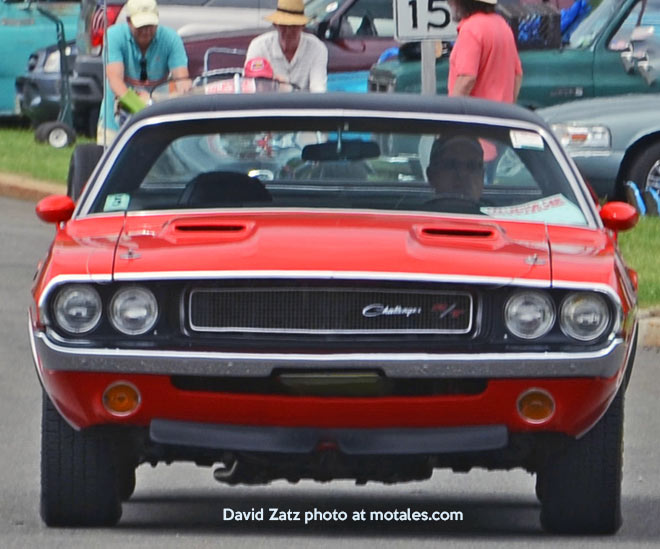
The low-priced Deputy might have been made to sell more Challengers by lowering the base price after a disappointing launch. They had no air conditioning, power steering, or power brakes, and some used base Barracuda seats. Fewer than ten were optioned out with the 383 engine and three-speed transmissions for a sort of Road Runner experience.
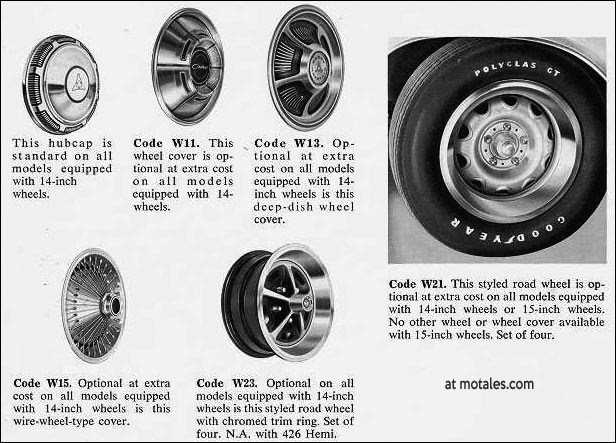
The Dodge Challenger SE, or Special Edition Challenger, coded JS23 normally and JS29 for the R/T, was a separate model; it was coded in the VIN as Special. This car had a “formal” style rear window, imitating a limousine, and created by putting a fiberglass cover over much of the rear window. The SE also had a special velour headliner and console (noted earlier) with warning lights and leather seat covers (buyers could also get a little credit towards another option by having fabric inserts in the leather). The SE was only sold in the 1970s; the vinyl-covered roof and formal rear window stayed on as an option package.

There was also a 1970 Dodge Challenger T/A, required by the racing series’ homologation rules. Special 1970 Challenger T/A models (and Barracuda AARs) went on sale with triple Holly carburetors atop a 340 V8. The racing version ran a rather different version of the engine with a four-barrel carburetor.
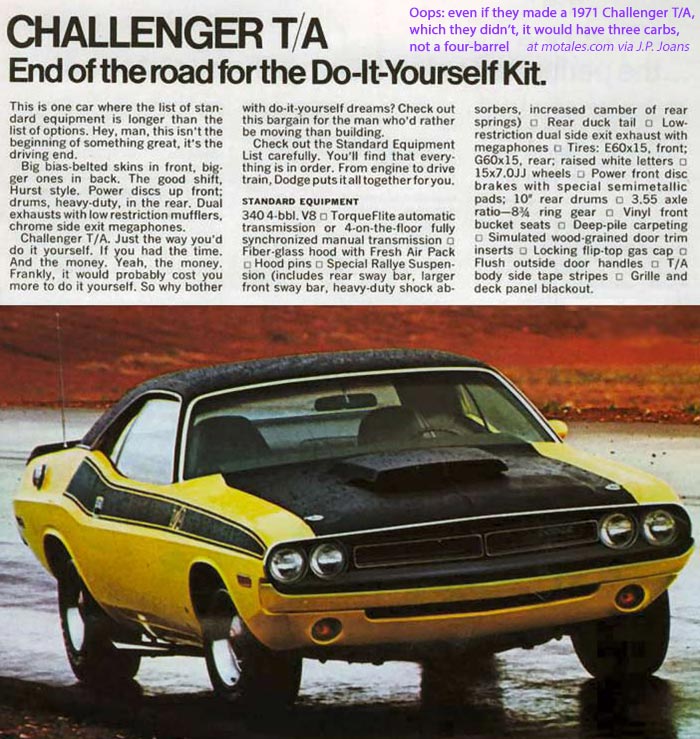
The retail cars came out early in 1970, made in March and April; transmissions were a four-speed manual or three-speed automatic transmission with a limited-slip differential. The suspension had special shocks and rear springs to add clearance for the exhaust pipes before the rear tires. They were the nation’s first assembly-line-made car with different sized wheels in front and rear (G60x15 rear, E60x15 front).
The Challenger T/A ran the quarter mile in 14.3 seconds, while Car & Driver ran 0-60 in 5.8 seconds. Hot Rod dyno-tested one and found 356 bhp and 382 lb-ft with stock manifolds, quite a bit more than the claimed figures.
The market for pony cars fell in 1970, and Chrysler failed to garner a 15% share. The estimations fell dramatically short and the cars lost money. The special Challenger and ’Cuda meant for racing turned out to be poorly assembled and failed in racing, too.
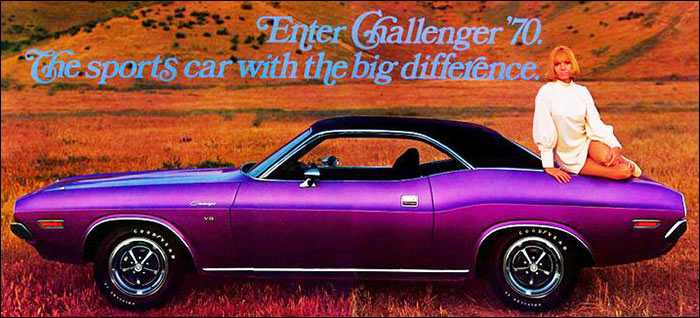
The Road Runner, launched in 1968, was a major competitor for youth dollars; it was cheaper and lighter, and provided better handling and acceleration for lower cost. Likewise, the 1970 Duster, an ironic replacement for the original Valiant-based Barracuda which was not entirely planned by the senior executives (it used money earmarked for a Valiant facelift), took off for its low cost, sporty-enough looks, and performance. The 340 Duster was a fine match for most Challengers and Barracudas, while the 318 was enough for most people but far more economical than a normal-performance 383 in a heavier car. The Challenger, in short, faced a market shortfall and tough internal competition.

Oddly enough, Australian engineers had also combined the A and B bodies, but their efforts were a major success. The Valiant Charger, though, wasn’t necessarily wider; it topped out with a Hemi-head, triple-carburetor 265 cubic inch straight-six created specially for that market. One does wonder if Chrysler hadn’t decide to match the competition’s big block engines, whether a truly restyled 340 Duster wouldn’t have done even better.
The 1970 Challenger sales tally was 83,032 total:
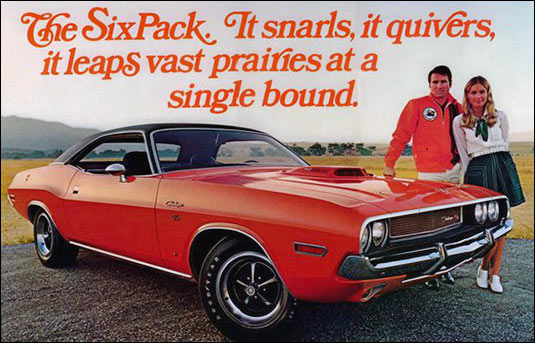
Roughly 60% of the cars had their base V8 engine, and around 90% had automatics. Regardless, sales were nowhere near as high as projected. Burton Bouwkamp summarized it: “We lost money (unhappy management) and we did not build the cars well (unhappy customers). 1970-1974 Barracudas and Challengers are admired and collected today but 35 years ago they were seen as problems.”
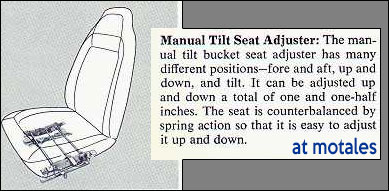
Plymouth sold 217,192 Dusters in 1970, and Duster sales were to rise—and the Duster was another sporty variant of Valiant, done on a much lower budget. Burt remembered:
I was lucky to keep my job as Director of Product Planning. It seemed like every time [Chrysler president] John Riccardo saw an E body, he got mad at me. Instead of a promotion to vice president, I got a new boss (George Butts) who was newly appointed the Vice President of Product Planning.
After the E-body fiasco I was on a dead end street at Highland Park so I “engineered” my way into the top product job in Europe. Glad I did, too — we did two European Cars of the Year in four years (we beat out new cars from BMW, Ford, GM, Renault, etc) and my confidence was restored.
Figures are for coupe, not hardtop or convertible. The base 318 V8 came with a 3.23:1 axle ratio with the manual, 2.76 with the automatic (3.23 optional). Space figures are not directly comparable to modern cars, especially the trunk measurements.
| Challenger | Inches |
|---|---|
| Wheelbase | 110 |
| Track (max) | 60.7 |
| Headroom, F/R | 37.4 / 35.6 |
| Legroom, F/R | 42.3/30.9 |
| Shoulder-room | 58.1 / 56.8 |
| Trunk (cubic feet) | 8.6 |
Chrysler’s SIMCA division imported some partly-made Challengers into Europe, installing headlights and trim in France to obey local production rules; in France, local parts included clear parking lamps/turn signals, Talbot rear view mirrors on the doors, and yellow-tinted headlights. German versions had a button on the end of the turn signal stalks to turn all four headlamps on at once, temporarily.

The suspension was essentially the same as other Mopars of the time, except that it was set up for better handling—though that might not have been successful.

(Following specs are from 1972 and cover all Dodges.)
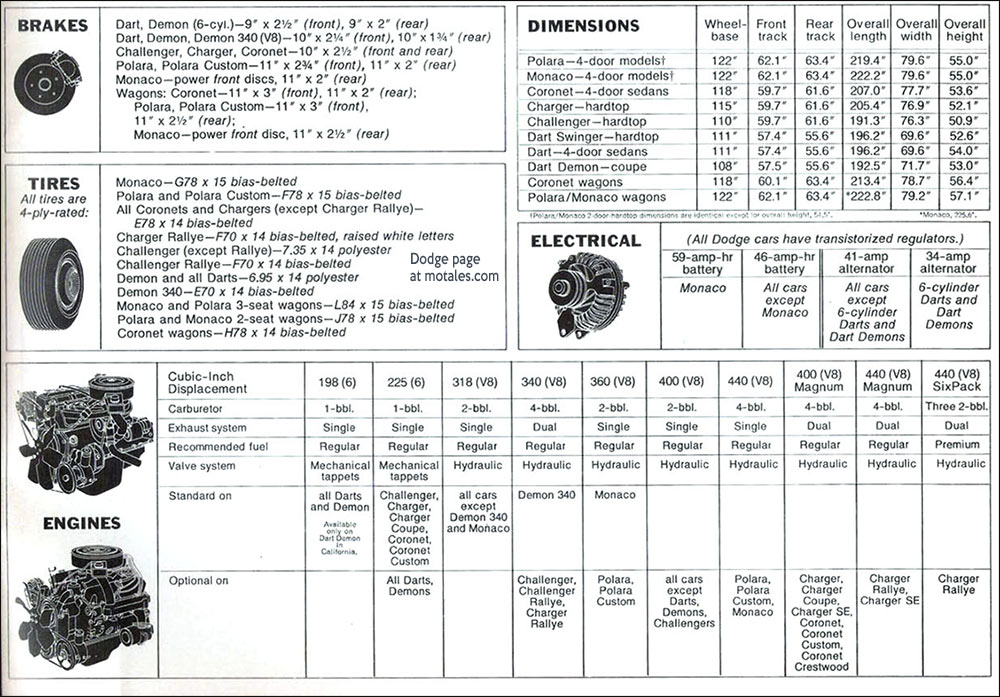
For 1971, Dodge made minor changes to the product line, dropping the U-code 440 V8 and restricting the hot 383 to the R/T. They also dropped the slow-selling convertible R/T and gave the SE a standard rear window, splitting the odd vinyl roof plus smaller rear window option into a separate package. Since Trans Am racing had failed dismally, they also dropped the Challenger T/A; by then, they had made thirty T/A cars for racing, but they converted those back into R/T models. One 1971 Challenger T/A ad ran in late 1970, as well, confusing the issue for later buyers. Most think the car was an airbrushed 1970; but it could have been a 1971 T/A which was converted to an R/T later. Either way, they did not sell a single 1971 Challenger T/A.
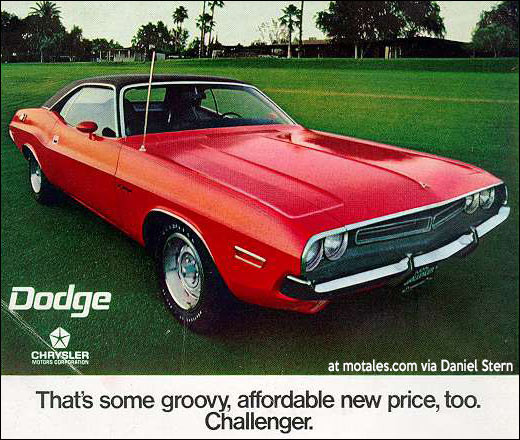
The Challenger Deputy continued for those who wanted the car’s style but not its price, with fixed rear side glass and a mere 198 slant six.
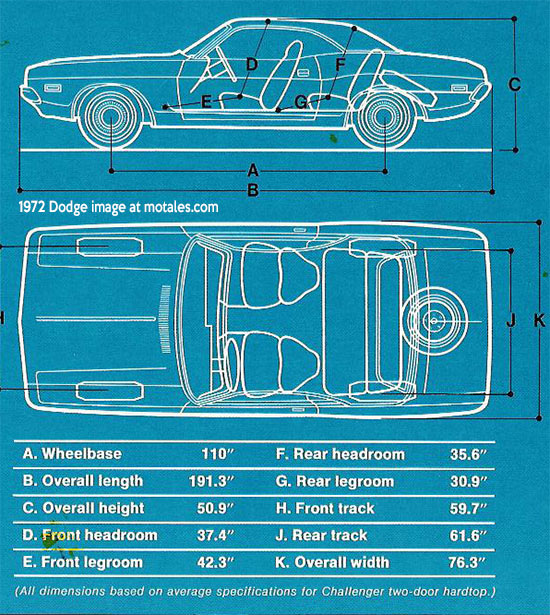
Annual styling changes amounted to switching from single to dual tail lights, and a new twin-inlet grille—silver on most cars, black with fiberglass louvers on R/T. The tooling for sheet metal was likely nowhere near being worn out (typically 100,000 stampings could be made), and changing plastics was cheaper and easier. The company likely started thinking about making 100,000 of the Plymouth and Dodge to get their money back from the tooling, rather than making 200,000 a year of both to fill assembly lines.
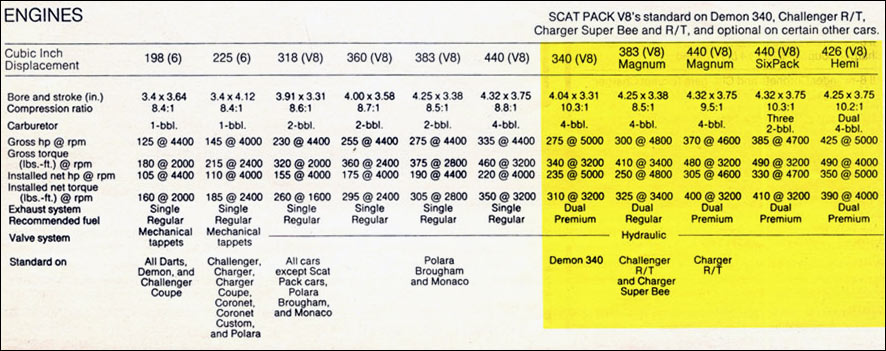
Emissions rules required slight detuning of the 383 and 440 Six-Pack, dropping power very slightly (e.g. 5 hp from the 440 Six-Pack). Many then and now think the changes were much more drastic because they also went from gross to net power measurements, so the horsepower and torque figures plummeted across the board. This table shows 1971 horsepower for selected engines:
| Engine | Gross | Net |
|---|---|---|
| 225 six | 145 | 110 |
| 318 V8 | 230 | 155 |
| 383 V8 | 300 | 250 |
Even with net horsepower, marketing played a role in the numbers until the modern era. The slant six output was, according to the head of engine tuning at the time, a mild overstatement; while the 340 Six-Pack was certainly understated. The numbers suspiciously tend to end in 0 or 5, suggesting quite inexact measurements.
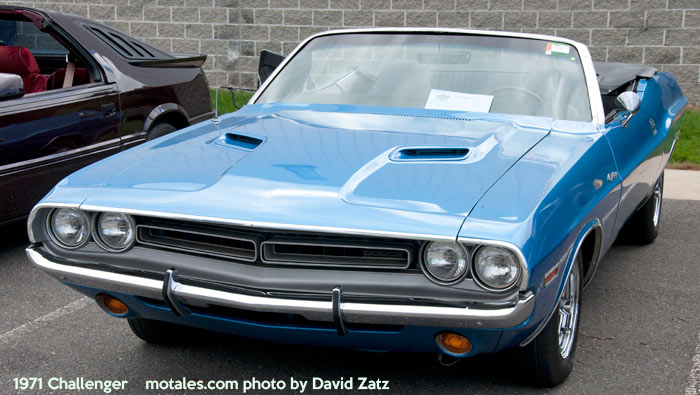
Those who wanted looks without gulping premium fuel could get a 318-powered, 340 R/T look-alike with a shaker, wing, and most of the R/T paraphernalia. Along the same lines, Dodge later converted some 1971 Challengers into 1972 convertibles for Medical Center, a popular television show.
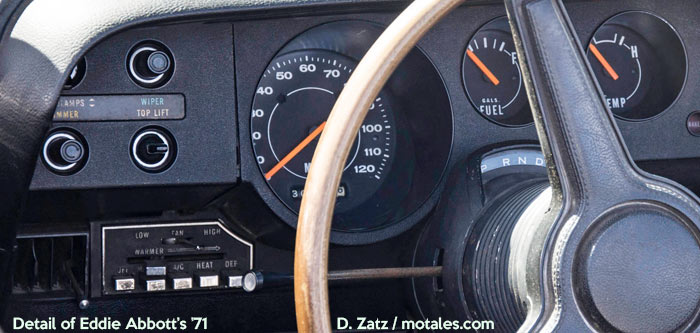
Sales still dropped in 1971, despite being the Indy 500 pace car, which famously crashed into the press box. The R/T was around 15% of production—but production was only around 30,000. The Challenger was easily outsold by the older Dodge Charger and even the Dart Swinger. Plymouth sold around 174,000 Dusters in the same year, 12,886 of which were the hot 340 Dusters (around twice as many as R/T Challengers). That said, the Plymouth Barracuda version of the Challenger was not selling well—with under 20,000 changing hands.
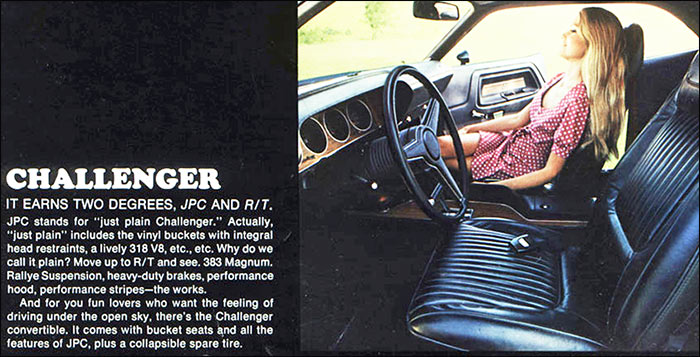
| Challenger | 1970-71 | 1973-74 |
|---|---|---|
| Length | 191.3 | 198.2 |
| Width | 76.1 | 76.4 |
Sales were still poor but the tooling was still good, so despite a rough market for heavy, fuel-guzzling compact muscle cars, the Challenger stuck around—in simpler form. Dodge combined the R/T and SE into a single Rallye model, and replaced the convertible with a better-selling, ~$400 sunroof.
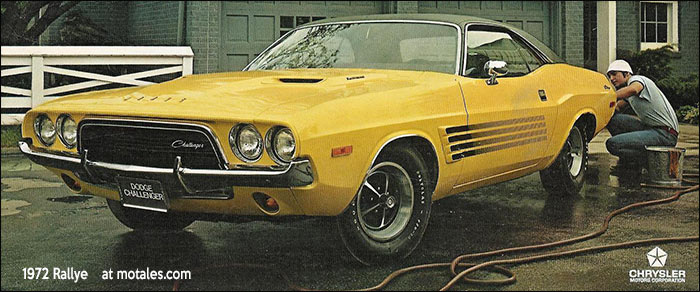
Most of the changes for 1972 were in the front appearance, which now had an “egg-crate” grille painted silver (on Rallye, black, with small scoops on the front fenders); the area around the headlights was painted rather than black, and the grille was shaped as a “sad mouth.” The rear split up the solid line of lights which the designers had been quite proud of.
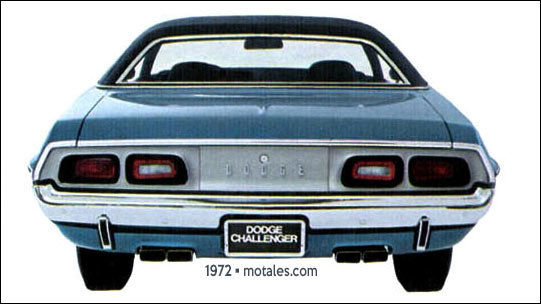
The Hemi was no longer made; they also dropped the 440 Six-Pack and 383 engines from the Challenger options, leaving the most powerful engine the 340 with 240 hp. The only other V8 was the 318 with 150 hp, net (net figures are roughly comparable to modern power measurements). The slant six was still available in 1972, but precious few were sold, and they were dropped by 1973. Production fell again, though, dropping below 26,000.
The Challenger and Barracuda competed against the Mustang/Cougar, Camaro/Firebird, and, to a lesser degree, the AMC Javelin. The Camaro and Duster had a 108 inch wheelbase, the Mustang was at 109 inches, and Challenger and Javelin shared 110 inches. In overall length, all the cars but Camaro were 190-192 inches (Camaro was 188, and Duster was 192.5). The Challenger was the widest of them all, at 76 inches; Javelin was 75, Mustang and Camaro were 74, and Duster was 72.
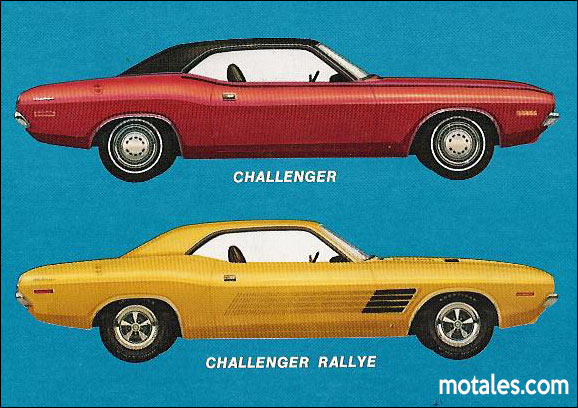
Inside, front headroom was about the same for all the cars; the Challenger had 37.4 inches and the rest were within 0.2 inches. Rear headroom was a bit different, with the Challenger lacking around half an inch from Mustang and Camaro, but sharing with Javelin—and a full inch less than the Duster. (The Firebird shared interior dimensions with the Camaro despite being inches longer; they had the same wheelbase, too. The difference may have been in trunk space.)
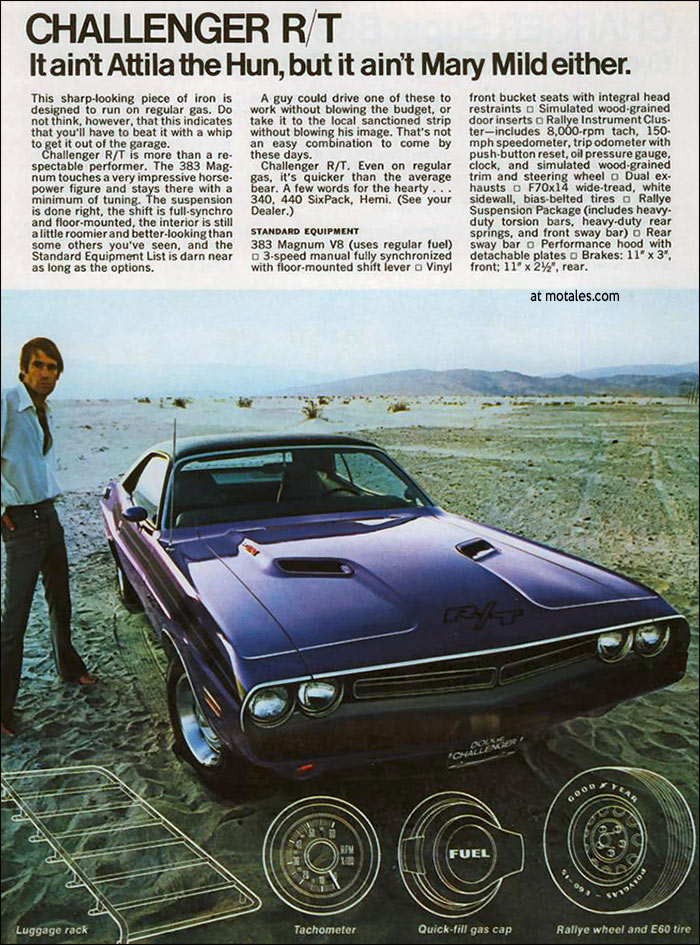
The Challenger, with its longer-than-Barracuda wheelbase, did well in legroom, where it matched the Javelin and beat the Mustang by three inches and Duster by two; but it was about an inch shorter than the Camaro. Trunk space was midpack at 8.6 cubic feet, a cubic foot less than the Mustang, two more than the Camaro, 1.5 less than Javelin, and roughly half that of the Duster. Brakes were much better than those of the Mustang, Javelin, or Duster in swept area, and similar to the Camaro.

Engine power was not much of a differentiator; the Dodge, Camaro, and of course the Plymouth all came in with identical ratings, with the AMC and Ford just 10 hp behind. The base V8 was another story:
| Base V8 | HP (Net) | Torque |
|---|---|---|
| Challenger | 150 | 260 |
| Mustang | 141 | 242 |
| Camaro | 130 | 230 |
| Javelin | 150 | 245 |
1973 brought huge bumper guards and few other changes; production rose to nearly 33,000. Vinyl front bucket seats with headrests were standard, along with a floor-mounted 3-speed manual transmission, ashtrays, heater/defroster, day/night mirror, concealed wipers, and dual horns. The passenger side mirror was optional, along with disc front brakes.
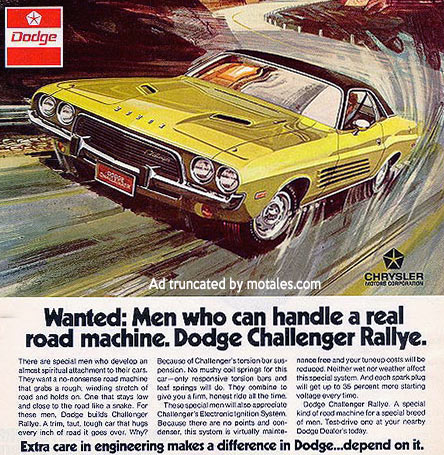


In 1974, there were two engine choices: the base 318 and a heavily upgraded 360. The latter replaced the 340, which had ended in 1973, and is often underestimated today since later versions were less thrilling. The 360, originally created for high torque in trucks and big cars, had a high-performance version for the 1974 cars; this had the 340’s ThermoQuad four-barrel carburetor and 268-276-44 cam. Power was rated at 245 hp, net, better than the prior year’s 340 four-barrel. The basic 318 was not a muscle engine but had good torque and wasn’t a bad match for the relatively light E-bodies.
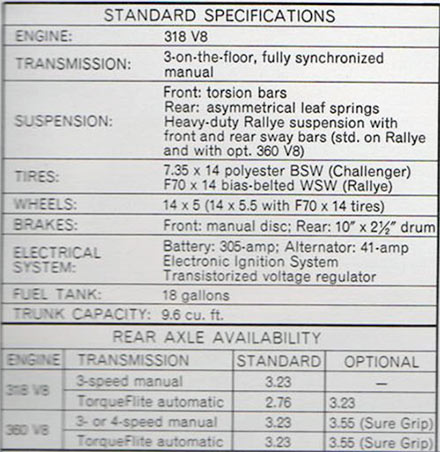
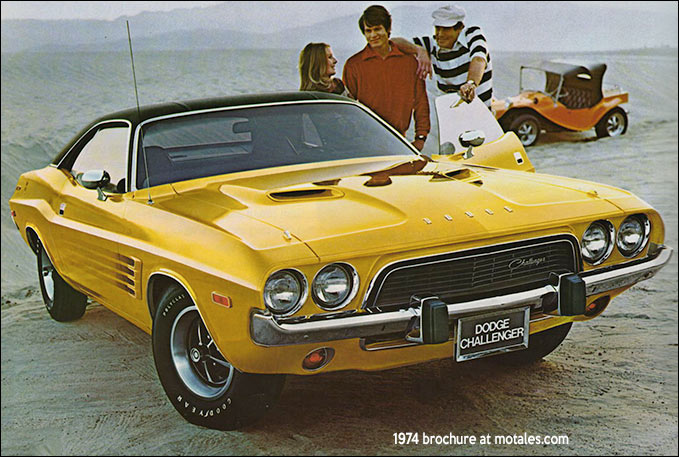
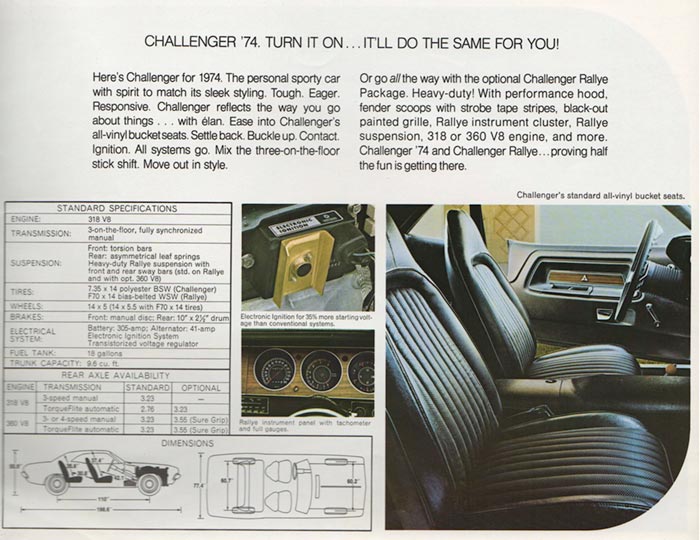

Lap and shoulder belts were now standard, due to federal law, and made into a single unit pulled from the floor. A single-year feature was the federally mandated seatbelt-ignition interlock. Production was a mere 16,000 units, though not because of the seat belts. With this final embarrassing sales figure, Dodge shut the Challenger down.

The name was resurrected to rebadge a Mitsubishi sporty compact car in the 1970s, then in 2008 for a rather well done and quite similar-looking car which was far more capable than the original: the 2008-2023 Dodge Challenger. Sales of this car were more reliable, and often far higher, than the original. Its six-cylinder engine produced 250 hp, net; its smallest V8, a 5.7 Hemi, produced 370 hp, and its most powerful engine eventually made 1,025 hp.
The original Challenger and Barracuda likely lasted as long as most of their tooling was in good shape; any further investment would have been unwise. Fuel shortages made the class of car much less desirable, regardless of power, and without big block engines, its main rationale for existence (beyond the Duster) disappeared.
Challengers were seen in many movies—Vanishing Point most notably, but also Phantasm (a later sequel required another car—they had to take a lower model and make cosmetic changes), Natural Born Killers, Used Cars, and others. They appeared on TV at the time in The Mod Squad.
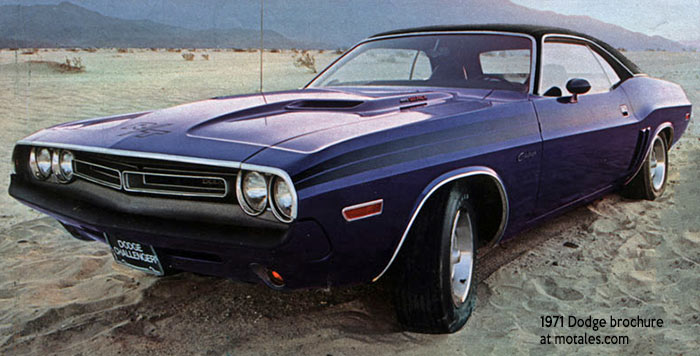
The Challenger was and is an impressive looking car, a true styling feat; but unlike the Charger, not much backed up the looks. The interior was small for the footprint, handling was only really good with the small-block engines, build quality was lacking, and the door trim added an annoyance. Timing was not good, either, with the Road Runner (coming out just after work on the Challenger started) and Duster (unknown to Dodge but familiar to Plymouth in 1967) stealing much of its thunder. The Road Runner / Super Bee likely captured most of the buyers intended for the Challenger, while the Duster would get the more price-conscious buyers. Perhaps the company would have been better off allocating a bit extra for the Duster front end to look the part more?

Roger Stark later said, “I often wondered if we had steered the light-and-nimble course, if the car would have had a much better chance at success. We would not have the Cuda Cult around, but we might have made some money!!”
Likewise, Burt Bouwkamp said, “Now the kids love them and the car enthusiast press gives glowing reports of the 1970 models. Where were they in 1970?”
Nobody predicted was that “compact specialty cars” would plummet in sales and that the big-engine power war would end so quickly and for so many reasons. Regardless, the car did not do well—but later grew in stature and desirability, so that when a new version finally appeared, it sold quite well and made numerous magazine covers.
See the modern 2008-2023 Dodge Challenger • 1,205-hp Dodge Demon 170
Also of interest? Dodge Viper book covering all generations by David Zatz (2022)
Copyright © 2021-2025 Zatz LLC • Chrysler / Mopar car stories and history.
YouTube • Editorial Guidelines • Videos
Tailfins Archive • MoTales on BlueSky